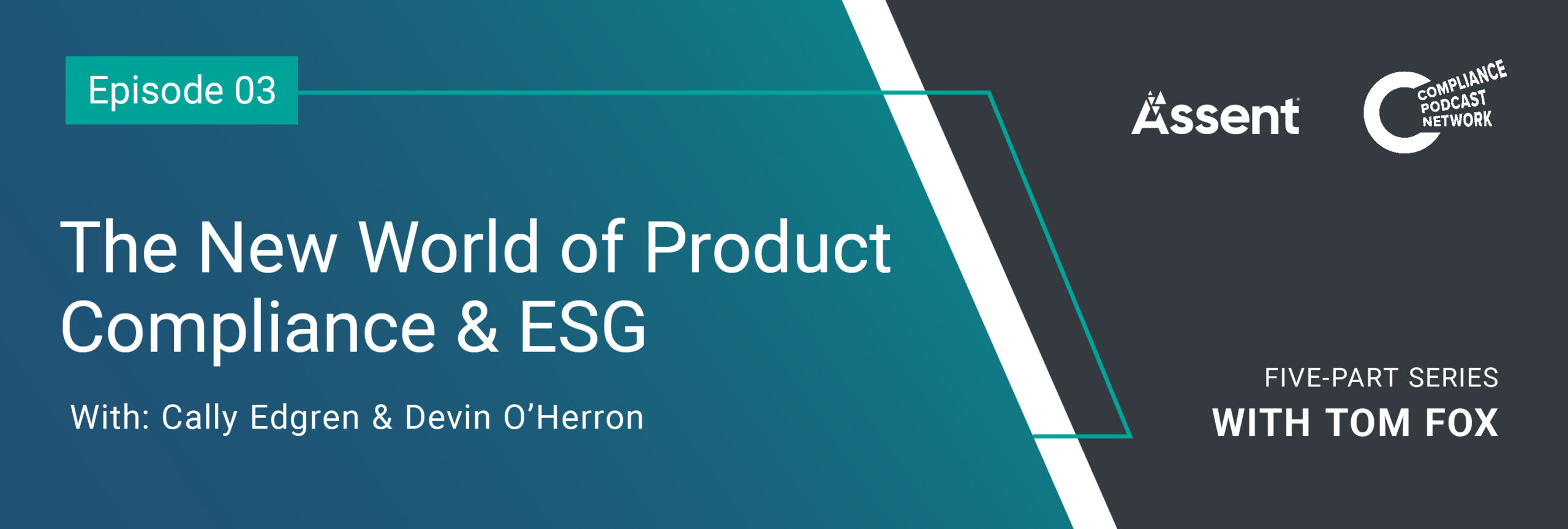I recently had the opportunity to visit with several folks from Assent Inc. for a sponsored podcast series entitled Supply Chain and ESG – What You Need to Know. We discussed: ESG drivers with Jared Connors and James Calder; UFLPA, Supply Chain and ESG with Travis Miller and Jamie Wallisch; the New World of Product Compliance and ESG, with Cally Edgren and Devin O’Herron; Emissions Reporting Strategies with Devin O’Herron and Jared Connors; and Responsible Minerals, Supply Chain and ESG, with Jared Connors and Daniel Zamora. Today we look at the new world of product compliance and ESG.
I certainly see safety as a key component of the ‘S’ in ESG. However, I had always focused on worker safety and perhaps greater environmental safety. Yet consumer product safety is also a component of the ‘S’. This is not new but combines topics and regulatory concerns in product compliance which have been gaining in importance for the past 20 years.
Edgren began with explaining that product compliance is a discipline focused on ensuring that products meet regulatory requirements where they are sold. Further, there is an evolution of those regulatory requirements. Product regulatory compliance used to be more traditionally things like electrical safety or mechanical safety, but then back in 2002, the Regulatory of Hazardous Substances (RoHS) came along. The RoHS directive applied design criteria to electrical products. The significance of this was that for purposes of the RoHS directive, it was not just tied to the safety of the user as traditional product compliance regulations were; it was actually tied to the safety of the third world countries, where the electronic waste ends up.
This created a regulatory obligation with more of a sustainability focus behind it versus the traditional product safety. Over the last 20 years there has been a tremendous explosion of these types of regulatory obligations. These aren’t just nice to do things. Edgren pointed to an example of the European Union’s (EU) Ecodesign Directive which established a framework to set mandatory ecological requirements for energy-using and energy-related products sold in all 27 member states. She noted, “both of these regulations, the RoHS directive and the EU Ecodesign Directive require compliance, or you cannot sell in locations where they are effective.” This is where the product compliance bridge comes back into the area of greater sustainability or environmentally focused regulations.
O’Herron expanded on this by noting, “there’s a lot of connection directly to the E in ESG with product compliance, as there’s a focus on environmental regulations and making sure that your products are meeting those environmental regulations.” But it is more than simply meeting regulatory expectations. He explained it “has to do with externalities. What are these costs of doing business? Not just the financial cost, which are fairly well established. It is the social and environmental costs as well, which have not “traditionally been quantified.”” He provided the example of the “environmental social cost involved with the disposal of toxic chemicals at the end of their life in electronics is unacceptable. We are becoming increasingly aware of the importance and relevance of these externalities and the barrier that they present towards sustainability, environmental, social, and governance metrics represent another way of starting to measure and manage those externalities.”
One of the greatest benefits to ESG, has been not simply the realization of the inter-connectedness of what were seemingly disparate areas of business. It is that companies are taking a much more holistic approach to looking at these issues. Edgren said we may not be there quite yet in the area of safety, but she believes it is an evolving process and dialogue. She said, “what I am seeing and what I have experienced, is we are starting to merge the environmental into the more traditional product safety. We are starting to elevate those conversations which in reality, are just different pieces of the same whole puzzle. We are starting to have those conversations. I don’t think that industry is a hundred percent there yet of connecting product safety to ESG, but that’s certainly part of the message that we are highlighting.”
It is this realization of inter-connectedness that may be the most import consequence from an overall corporate ESG approach. In 2020, the Department of Justice (DOJ) released the Update to the Evaluation of Corporate Compliance Programs which mandated that the corporate compliance function have access to all corporate data. No more siloes for compliance. When you take that attitude and apply it to an ESG framework, you begin to see the power of integrating all these data points to make your overall business more robust, more resilient and more cohesive.
Join me tomorrow where look at a Scope 3 emissions reporting strategy.
To listen to the podcast this blog post is based upon, click here.




